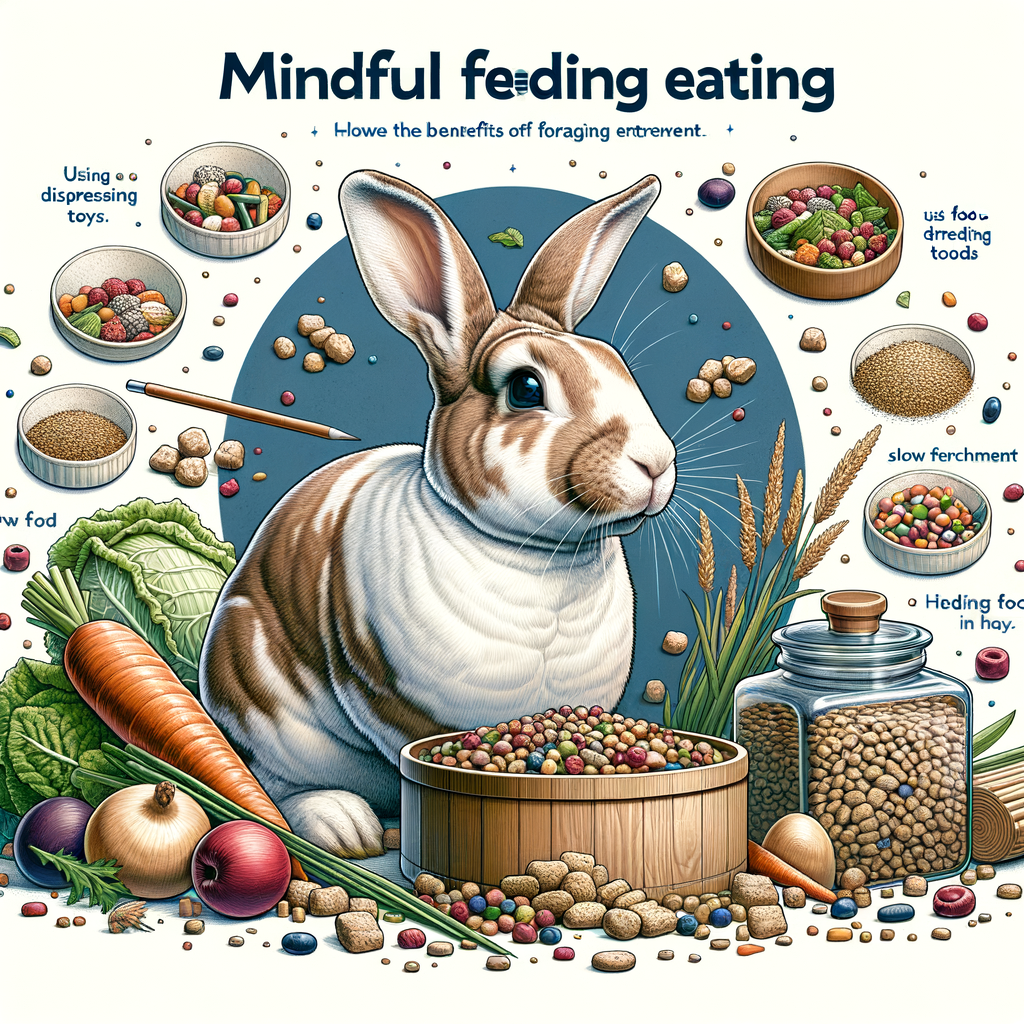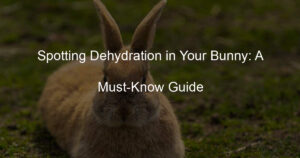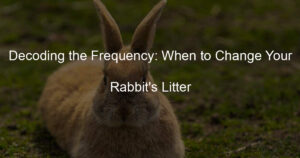
Introduction to Rabbit Feeding Habits
Understanding the feeding habits of rabbits is crucial for their health and well-being. This section will delve into the natural diet of rabbits, the importance of hay, and the role of fruits and vegetables in their diet.
- Understanding the natural diet of rabbits
- The importance of hay in a rabbit’s diet
- The role of fruits and vegetables in a rabbit’s diet
Rabbits are herbivores, meaning they only eat plants. In the wild, they primarily feed on grasses, hay, and leafy weeds. They also enjoy a variety of fruits and vegetables. Their diet is high in fiber, which is essential for their digestive system. Understanding their natural diet helps us provide them with the right food in captivity.
Hay is a crucial part of a rabbit’s diet. It provides the necessary fiber for a healthy digestive system and helps grind down their constantly growing teeth. In fact, hay should make up about 70% of an adult rabbit’s diet. Without hay, rabbits can suffer from serious health problems.
Fruits and vegetables are also important in a rabbit’s diet. They provide essential vitamins and minerals that are not found in hay. However, they should be given in moderation as too much can lead to obesity and other health issues. A good rule of thumb is to feed your rabbit a variety of vegetables daily and fruits as occasional treats.
Understanding and implementing these feeding habits will ensure your rabbit stays healthy and happy. Remember, a well-fed rabbit is a happy rabbit!
Mindful Eating for Pets: A Closer Look at Rabbits
When it comes to feeding our pets, it’s essential to consider not just what they eat, but also how they eat. This is where the concept of mindful eating comes into play. Let’s take a closer look at mindful eating, particularly for rabbits.
What is Mindful Eating?
Mindful eating is a practice that encourages being fully attentive to the eating process. It’s about paying attention to the flavors, textures, and smells of the food, as well as the act of eating itself. But how does this apply to pets, and why is it important?
- Definition and importance of mindful eating: Mindful eating is about being present and attentive during meal times. For pets, this means providing them with a calm and distraction-free environment to eat. This practice can help pets better enjoy their meals and reduce overeating or under-eating, which can lead to various health issues.
- Benefits of mindful eating for pets: Mindful eating can have numerous benefits for pets. It can help maintain a healthy weight, improve digestion, reduce stress, and even enhance the bond between pets and their owners. By paying attention to their eating habits, we can better understand their needs and preferences, leading to happier and healthier pets.
Now that we understand what mindful eating is and why it’s important, let’s delve deeper into how this concept applies to rabbits. Stay tuned for the next section where we will discuss how to promote mindful eating in rabbits and the benefits it can bring to our furry friends.
Mindful Eating in Rabbits
Mindful eating is a practice that can significantly improve the health and well-being of your pet rabbit. Let’s explore how to promote this habit and the benefits it brings.
- How to Promote Mindful Eating in Rabbits
- Provide a Variety of Foods: Offering a mix of hay, vegetables, and a small amount of fruits can stimulate your rabbit’s interest in food and encourage slower, more mindful eating.
- Slow Feeding Techniques: Using slow feeding bowls or toys can help your rabbit eat more slowly and mindfully. This can also provide mental stimulation, promoting overall well-being.
- Monitor Eating Habits: Keep an eye on how much and how quickly your rabbit eats. If you notice any changes, it may be time to adjust their diet or feeding methods.
- Benefits of Mindful Eating for Rabbits
- Improved Digestive Health: Eating slowly helps prevent digestive issues, such as GI stasis, a common issue in rabbits.
- Better Weight Management: Mindful eating can help prevent overeating and obesity, a common problem in domestic rabbits.
- Enhanced Mental Well-being: Engaging with a variety of foods and eating slowly can provide mental stimulation, reducing boredom and stress.
Encouraging mindful eating in rabbits involves a few key steps:
Mindful eating can have numerous benefits for your rabbit, including:
| Promotion Techniques | Benefits |
|---|---|
| Providing a variety of foods, using slow feeding techniques, monitoring eating habits | Improved digestive health, better weight management, enhanced mental well-being |
Slow Feeding for Rabbits: An Essential Practice
When it comes to feeding your pet rabbit, there’s a method that can significantly improve their health and happiness. This method is known as slow feeding. Let’s delve into what slow feeding is and why it’s so important for rabbits.
Understanding Slow Feeding
- What is slow feeding?
- Why is slow feeding important for rabbits?
Slow feeding is a practice where you control the speed at which your rabbit eats. This is typically achieved by using specially designed feeders or toys that make your rabbit work a little harder for their food. Instead of gulping down a bowl of food in a few minutes, your rabbit will take a longer time to eat the same amount.
Slow feeding is crucial for rabbits for several reasons. Firstly, it mimics the natural foraging behavior of rabbits in the wild. In nature, rabbits spend a large part of their day searching for food and eating slowly. This keeps them mentally stimulated and physically active.
Secondly, slow feeding can help prevent health issues such as obesity and gastrointestinal problems. Rabbits have a unique digestive system that needs a constant supply of food to work properly. By slowing down the rate at which your rabbit eats, you can ensure that their digestive system is always working optimally.
Lastly, slow feeding can help reduce boredom and behavioral problems. Rabbits are intelligent animals that need mental stimulation. By making them work for their food, you can keep them engaged and happy.
In conclusion, slow feeding is an essential practice for rabbit owners. It not only helps keep your rabbit healthy but also contributes to their overall well-being. So, if you haven’t already, consider incorporating slow feeding into your rabbit’s daily routine.
Benefits of Slow Feeding in Rabbits
Slow feeding is a practice that offers numerous benefits to your furry friend. Let’s delve into the three main benefits of slow feeding in rabbits.
- Improvement in Digestion
- Prevention of Obesity
- Enhancement of Mental Stimulation
Rabbits have a unique digestive system that requires a constant supply of food. Slow feeding ensures that food is gradually and consistently available, which aids in maintaining a healthy digestive process. It helps to prevent gastrointestinal stasis, a common but serious condition in rabbits. This practice also encourages the natural chewing process, which is essential for dental health.
Obesity is a common health issue in pet rabbits, often due to overfeeding or lack of physical activity. Slow feeding helps to control the amount of food your rabbit consumes, reducing the risk of weight gain and obesity. It also encourages more physical activity as your rabbit spends more time foraging and less time eating quickly and idly.
Rabbits are intelligent creatures that require mental stimulation to stay happy and healthy. Slow feeding encourages foraging behavior, which is a natural and mentally stimulating activity for rabbits. It keeps them engaged and active, reducing the risk of boredom and related behavioral issues.
In conclusion, slow feeding is a beneficial practice that can significantly improve your rabbit’s health and well-being. It’s a simple change that can make a big difference, so why not give it a try?
Foraging Behavior in Rabbits: A Natural Instinct
Foraging is a fundamental part of a rabbit’s lifestyle, deeply rooted in their natural instincts. Let’s delve into understanding this behavior and why it’s so important for our furry friends.
- Understanding the foraging behavior in rabbits
Rabbits are natural foragers. In the wild, they spend a significant part of their day searching for food. This behavior is not just about satisfying their hunger. It’s also a way for them to stay active and mentally stimulated. Foraging allows rabbits to use their senses of smell and taste, and it also encourages their natural digging and chewing behaviors.
Domestic rabbits still retain this instinct. Even when provided with ample food, they will often display foraging behaviors. This could be seen in their tendency to dig into their food bowls or scatter their food around.
- Why is foraging important for rabbits?
Foraging is essential for rabbits for several reasons. Firstly, it helps to keep them physically active. This is crucial as it helps prevent obesity, a common health issue in domestic rabbits. Secondly, foraging stimulates their minds, which can help to prevent boredom and related behavioral issues.
Additionally, the act of foraging helps to wear down a rabbit’s teeth, which continuously grow throughout their life. Chewing on a variety of foods can help to maintain healthy teeth and prevent dental problems.
Lastly, foraging behavior is a significant part of a rabbit’s natural behavior. Encouraging this can help to ensure your rabbit is happy and behaving as naturally as possible.
In conclusion, understanding and encouraging your rabbit’s natural foraging behavior is an essential part of caring for them. It contributes to their physical health, mental stimulation, and overall well-being.
Encouraging Foraging in Rabbits: Tips and Techniques
Foraging is a natural behavior for rabbits. It not only provides them with physical exercise but also keeps them mentally stimulated. Here are some tips and techniques to encourage foraging in your pet rabbits.
Foraging Enrichment for Rabbits
Foraging enrichment involves creating an environment that encourages your rabbit to search for food, mimicking their natural behavior in the wild. Here are two key ways to provide foraging enrichment for your rabbits:
- Creating a foraging-friendly environment: Scatter your rabbit’s food around their habitat to encourage them to search for it. You can hide food under toys, inside tunnels, or in different corners of their enclosure. This not only keeps your rabbit active but also stimulates their natural instinct to forage.
- Using foraging toys and tools: There are various foraging toys available in the market that can make foraging a fun and challenging activity for your rabbit. These toys often require the rabbit to manipulate them in a certain way to get to the food. This not only provides physical exercise but also mental stimulation for your rabbit.
Remember, foraging should be a fun and rewarding experience for your rabbit. Start with easy hiding spots and gradually increase the difficulty as your rabbit gets better at foraging. Always monitor your rabbit during foraging activities to ensure they are safe and enjoying the process.
Mindful Feeding Techniques for Rabbits
Feeding your rabbit is not just about providing nourishment. It’s also about building a bond and ensuring their overall well-being. Here are two mindful feeding techniques that can help you achieve this:
- Introducing New Foods Slowly
- Using Feeding Time as Bonding Time
Rabbits have sensitive digestive systems. Introducing new foods too quickly can cause discomfort or even illness. Instead, introduce new foods gradually over a period of 7-10 days. Start with a small amount and gradually increase the portion. This allows your rabbit’s digestive system to adjust to the new food. Remember, fresh vegetables and fruits should only make up a small portion of your rabbit’s diet. The majority should be hay.
Feeding time is an excellent opportunity to build a bond with your rabbit. Instead of just dropping food into their cage, take a few minutes to hand-feed them. This not only allows you to monitor their eating habits but also helps to build trust and affection. Make sure you are calm and gentle during this time. Quick movements or loud noises can scare your rabbit.
Remember, every rabbit is unique. What works for one may not work for another. Always observe your rabbit’s behavior and adjust your feeding techniques as necessary. And of course, if you have any concerns about your rabbit’s eating habits, consult with a vet.
Healthy Eating Habits for Rabbits: A Comprehensive Guide
Understanding the dietary needs of your pet rabbit is crucial for their overall health and well-being. This guide will provide you with comprehensive information on rabbit diet and nutrition, including the essential nutrients they require and how to create a balanced diet for them.
Rabbit Diet and Nutrition
Rabbits have unique dietary needs that must be met to ensure they live a long, healthy life. Let’s delve into the specifics.
- Essential nutrients for rabbits
- Fiber: This is vital for a rabbit’s digestive health. The best source of fiber for rabbits is hay, which should make up the majority of their diet.
- Protein: Rabbits need protein for growth and repair. Good sources of protein for rabbits include leafy greens and commercial rabbit pellets.
- Vitamins and Minerals: Rabbits need a variety of vitamins and minerals, including calcium and vitamin A. These can be found in a variety of fruits and vegetables.
- Creating a balanced diet for your rabbit
- Hay: This should make up about 70% of your rabbit’s diet.
- Vegetables: Fresh, leafy greens should make up about 20% of your rabbit’s diet.
- Pellets: High-quality rabbit pellets should make up about 5% of your rabbit’s diet.
- Fruits: These can be given as treats and should make up no more than 5% of your rabbit’s diet.
Rabbits require a variety of nutrients for optimal health. These include:
Creating a balanced diet for your rabbit involves providing a variety of foods in the right proportions. Here’s a simple guideline:
Remember, every rabbit is unique and may have specific dietary needs. Always consult with a vet to ensure your rabbit’s diet is meeting their nutritional needs.
Key Takeaways: Promoting Healthy Eating Habits in Rabbits
- Importance of Mindful Eating and Slow Feeding
- Encouraging Natural Foraging Behavior
- Maintaining a Balanced Diet
Rabbits are naturally fast eaters. However, slow and mindful eating is crucial for their health. It helps prevent obesity and gastrointestinal problems, which are common in rabbits. Slow feeding also ensures that your rabbit gets the most nutrients from their food. To promote slow feeding, you can use feeding balls or scatter food around their enclosure to encourage them to take their time eating.
Rabbits are natural foragers. In the wild, they spend a significant portion of their day searching for food. Encouraging this behavior in pet rabbits can help keep them active and mentally stimulated. It can also help prevent obesity. You can encourage foraging by hiding food in different parts of their enclosure or using foraging toys.
A balanced diet is crucial for your rabbit’s health. Rabbits need a diet that is high in fiber and low in fat. This should include a mix of hay, fresh vegetables, and a small amount of pellets. A balanced diet helps ensure that your rabbit gets all the nutrients they need and helps prevent health problems. Remember, every rabbit is unique, and their dietary needs may vary based on their age, size, and health condition.




